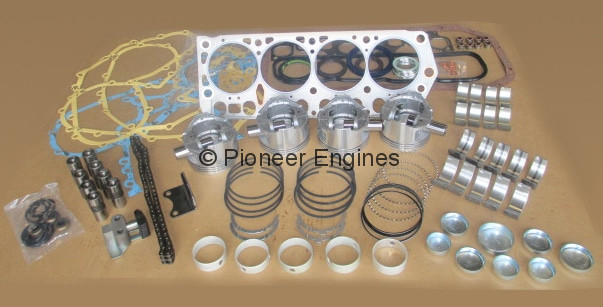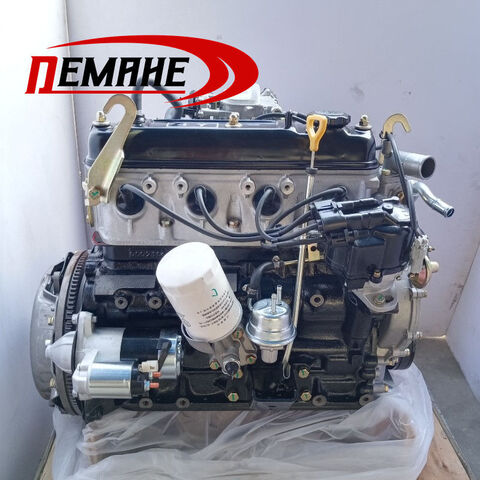Why the 4Y Engine Is a Top Choice for Reliable and Long-Lasting Performance
Why the 4Y Engine Is a Top Choice for Reliable and Long-Lasting Performance
Blog Article
Why the Engine Is the Finest Selection for Efficiency and Efficiency in Your Auto
The engine stays a crucial part in automobile layout, mainly because of its significant impact on both performance and efficiency. As improvements in innovation enable smaller sized engines to deliver amazing power while enhancing gas economy, the combination of attributes such as turbocharging and hybrid systems becomes significantly important. These innovations not just enhance driving experience yet likewise address ecological issues. The concern occurs: how do these aspects coalesce to redefine our understanding of auto efficiency? Discovering this balance exposes much deeper insights right into the future of engine layout.
Understanding Engine Kind
Recognizing the various kinds of engines is essential for optimizing performance and performance in vehicle style. The main engine types consist of inner combustion engines (ICE), electrical engines, and hybrid systems, each offering unique advantages and constraints.
Inner burning engines, which can be additional classified into gas and diesel variants, count on the burning of gas to generate power. Fuel engines generally give higher RPMs and much better velocity, while diesel engines are understood for their torque and gas effectiveness, making them suitable for sturdy applications.
Electric engines, on the various other hand, make use of electrical motors powered by batteries or gas cells. They use rapid torque distribution, causing smooth acceleration and lower discharges. The effectiveness of electrical engines is significantly greater than that of ICEs, making them a prominent selection for eco-conscious consumers.
Crossbreed systems combine both internal burning and electric engines, leveraging the toughness of both technologies. They optimize gas consumption by using electrical power at reduced rates and switching over to gasoline or diesel for greater speeds or heavier lots.
Choosing the best engine type is crucial for accomplishing wanted efficiency metrics and environmental sustainability in modern-day automotive design.
The Impact of Engine Size
Engine size regularly plays a crucial function in identifying a vehicle's efficiency and performance. Usually measured in liters or cubic centimeters, engine size directly affects the power result and torque characteristics of a car.
Nevertheless, raised engine dimension usually correlates with diminished fuel effectiveness. Larger engines take in more fuel, causing higher discharges and operational expenses. As a result, suppliers must balance the demand for power with the demand for gas economy. Smaller engines can deliver adequate performance for day-to-day driving while advertising much better effectiveness, making them a preferred selection in portable and mid-size automobiles.
Furthermore, advancements in engine style, such as turbocharging and straight gas injection, enable smaller sized engines to accomplish power degrees similar to their bigger equivalents. This trend emphasizes the importance of not solely concentrating on engine size yet likewise taking into consideration general car layout and innovation (4y engine). Inevitably, the impact of engine dimension on performance and performance highlights the demand for consumers to analyze their particular driving demands and preferences when picking a car
Advanced Engine Technologies
Technologies in engine technologies have actually dramatically reshaped the landscape of vehicle efficiency and efficiency, building upon the fundamental principles developed by engine size. Notably, improvements such as turbocharging and straight gas injection have actually made it possible for smaller engines to deliver power levels previously connected with bigger equivalents. Turbochargers press air entering the engine, allowing for boosted power result without a corresponding increase in engine size, while direct injection optimizes fuel shipment, improving combustion effectiveness.
In addition, variable valve timing systems have actually become a vital innovation, enabling engines to change valve operation based on driving conditions. This flexibility improves both performance during velocity and fuel efficiency throughout travelling. Crossbreed and electrical engine modern technologies even look what i found more illustrate the change in automotive layout, incorporating typical inner burning engines with electric motors to make the most of efficiency while decreasing emissions.
Additionally, developments in products scientific research have resulted in lighter, more sturdy engine parts, additionally improving performance and long life. The assimilation of innovative electronics and engine control devices additionally permits real-time changes, making certain optimal efficiency throughout various problems. Collectively, these advanced engine technologies not just improve next lorry efficiency but additionally contribute to an extra lasting automotive future, showing the continuous evolution of engine layout.
Balancing Power and Performance
Striking a balance in between power and effectiveness is essential in modern-day automobile layout as makers seek to fulfill increasingly rigid emissions guidelines while satisfying customer need for performance (4y engine). The obstacle hinges on enhancing engine attributes to provide robust power outcome without sacrificing fuel economic situation
To achieve this equilibrium, designers employ various approaches, such as turbocharging, which enhances engine power forcibly in even more air, enabling a smaller engine variation that boosts fuel effectiveness. Variable shutoff timing technologies likewise play a significant function, allowing engines to readjust their efficiency features based on driving problems, therefore enhancing both power and efficiency.
Furthermore, improvements in products and making techniques have resulted in lighter engine elements, which minimize total lorry weight and improve fuel efficiency without jeopardizing power. Hybrid innovations have actually likewise arised as a sensible remedy, incorporating traditional internal combustion engines with electric powertrains to offer a boost in performance while preserving lower exhausts.

Future Fads in Engine Style

Furthermore, the growth of sophisticated products, such as lightweight compounds and high-strength alloys, is set to change engine components. These products not only minimize weight but likewise boost thermal effectiveness, therefore enhancing performance. In addition, makers are exploring variable compression proportions, enabling engines to adjust to different driving conditions, boosting both power output and fuel economic situation.
Even more, the surge of expert system and maker learning in engine style is making it possible for anticipating maintenance and real-time performance optimization. This modern technology can lead to engines that self-adjust for maximum effectiveness based upon driving find more patterns.

Conclusion
Finally, the engine functions as a crucial component in accomplishing ideal efficiency and performance in modern-day vehicles. Advanced technologies, such as turbocharging and hybrid systems, improve power outcome while lessening fuel intake and exhausts. The interaction between engine size and style remains to advance, driving innovations that balance exciting performance with environmental sustainability. As automotive engineering progresses, the focus on developing reliable, effective engines will certainly continue to be vital fit the future of transport.
Additionally, advancements in engine design, such as turbocharging and straight gas injection, allow smaller engines to achieve power levels equivalent to their larger equivalents.Advancements in engine modern technologies have actually substantially improved the landscape of vehicle performance and performance, structure upon the fundamental principles developed by engine size. Turbochargers press air going into the engine, allowing for raised power outcome without a corresponding rise in engine size, while straight injection maximizes gas delivery, boosting combustion performance.
Hybrid and electrical engine innovations further show the shift in vehicle design, integrating traditional inner combustion engines with electrical motors to optimize efficiency while lowering emissions.
Jointly, these sophisticated engine technologies not just improve car efficiency but likewise add to a more lasting auto future, demonstrating the continuous evolution of engine style. (4y engine)
Report this page